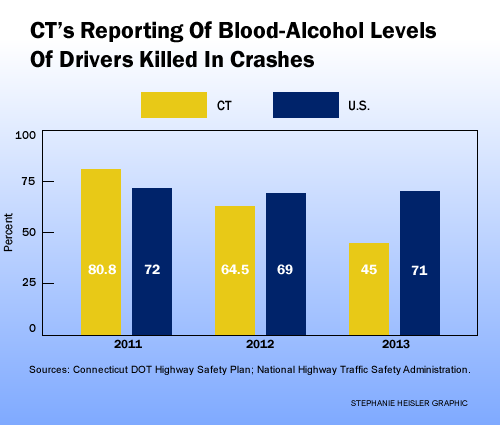Connecticut had one of the highest rates in the nation of motor vehicle fatalities in which drivers were alcohol impaired in 2013, the most recent year for which data is available – 41 percent, compared to the national average of 31 percent, according to federal estimates.
But the state also had one of the lowest rates nationally of reporting drunk-driving data in fatal accidents – a lapse that hampers efforts to gauge the impaired-driving problem and to develop and evaluate programs to address it, experts say.
 Connecticut reported blood-alcohol concentration (BAC) results for just 45 percent of fatally injured drivers — far lower than the national average of 71 percent, according to data collected by the National Highway Traffic Safety Administration (NHTSA). Only Mississippi reported a lower rate of such testing. Thirty-four states reported testing rates of more than 70 percent.
Connecticut reported blood-alcohol concentration (BAC) results for just 45 percent of fatally injured drivers — far lower than the national average of 71 percent, according to data collected by the National Highway Traffic Safety Administration (NHTSA). Only Mississippi reported a lower rate of such testing. Thirty-four states reported testing rates of more than 70 percent.
Connecticut also reported BAC test results for just 27 percent of surviving drivers involved in fatal accidents – lower than the national average, and despite a state law mandating such testing when police suspect that an operator is under the influence of alcohol or drugs.
All states report BAC results to the federal Fatality Analysis Reporting System (FARS), a nationwide census of fatal traffic accidents that enables the NHTSA, Congress and policymakers to gauge regional and national impaired-driving rates and other safety problems.
“You need good data to determine what the scope of the problem is and where to put your resources,” said Kara Macek, a spokeswoman for the Governors Highway Safety Administration, which encourages states to develop systems to ensure that all BAC results on deceased and surviving drivers are reported. “It’s an essential ingredient in the highway safety fight.”
Connecticut law requires that the chief medical examiner’s office test a blood sample from any driver who dies in a motor vehicle accident. In 2013, 183 drivers were killed, but only 83 had known BAC results. That reporting rate was worse than in 2012, when Connecticut reported BAC results for 64.5 percent of dead drivers – still lower than the national average of 69 percent. In 2011, the state’s reporting rate had topped 80 percent.
Both the NHTSA and the National Transportation Safety Board (NTSB) have recommended that states take action to improve their federal BAC reporting rates to 80 percent for fatally injured drivers and at least 60 percent for those who survive crashes. By not reporting BAC results, states “will not have the necessary tools to determine whether impaired driving programs and other countermeasures are meeting their goals,” the NTSB said in a 2012 report.
The state’s chief medical examiner, Dr. James Gill, who was appointed in 2013, said the decline in reporting appears to stem from a previous backlog in toxicology testing, as well as a lack of communication among state agencies and police. He said his office conducts toxicology tests on all dead drivers, but in 2013, there was a five- to six- month delay in testing, meaning that some results were not ready in time for federal reporting. The backlog problem has since been resolved.
The larger problem appears to be bureaucratic. The medical examiner’s office does not report BAC results directly to the state Department of Transportation (DOT), which compiles the federal data and is supposed to use it to formulate drunk-driving strategy. Instead, test results sit at the medical examiner’s office or are given to local or state police. In cases where drivers die in hospitals, police departments sometimes have trouble getting blood-test results, Gill said.
“I’m not sure where the ball was dropped,” Gill said of the low reporting rate. “The blood-alcohols are there — it’s a matter of not reporting them.” He acknowledged that such reporting is an “important public health matter” that helps to gauge the drunk-driving problem.
The NHTSA, in compiling state-level data, uses a statistical model to estimate the number of fatalities that are alcohol-impaired, in the absence of state reporting. But the agency says that “accurate and complete” reporting by states is “critical in monitoring alcohol-impaired-driving rates across the country, developing alcohol-impaired-driving programs, and evaluating their effectiveness.”
States submit data on fatalities to the federal FARS system. Harley Polverelli, an analyst with the state DOT who is responsible for the FARS program, said she scrambles to collect BAC results on deceased and surviving drivers from police and the medical examiner’s office, but is not always successful.
“Once we get notified of a fatal, I have to track down the BAC results” from police departments and the medical examiner, she said. “I have to poke and prod, ‘please get me that information.’ Some police departments are really good about it; others are not.”

CT.gov Photo.
Dr. James Gill, state medical examiner.
For drivers who survive accidents in which others are killed or seriously injured, state law requires police to obtain a blood or breath sample if an officer has “probable cause” to believe the driver operated under the influence of alcohol, drugs or both. Connecticut reported BAC levels on 51 of 186 surviving drivers (27 percent) in 2013; 56 drivers were not tested, and the rest are listed in federal data as “unknown if tested.” Twenty states had testing rates over 40 percent, NHTSA data show.
Putnam Police Chief Rick Hayes, president of the Connecticut Police Chiefs Association, said BAC results on surviving drivers are sometimes difficult to obtain because of the “probable cause” requirement, as well as refusals by some drivers and procedural barriers to getting blood-test results from hospitals.
“As a chief, I would like to see mandatory testing of anyone involved in a fatal accident,” he said. Only a handful of states have such laws; most have similar probable cause requirements.
Janice Heggie Margolis, director of the Connecticut chapter of Mothers Against Drunk Driving (MADD), said the state needs to improve its BAC reporting of fatally injured drivers.
“That’s really disturbing,” she said of the low reporting rate. “If we’re not reporting accurate numbers, how can we know what the true situation is?”
She said she favors testing for all surviving drivers involved in fatal crashes, in part because such testing could help to identify alcohol or drug problems among those drivers. “For families, if there’s an issue with alcohol or drugs, they have the right to know,” she said.
The NHTSA says the BAC testing and reporting process “will not succeed unless the people and agencies involved know their responsibilities and have the knowledge, resources, and management support to carry them out…These agencies need to agree on roles, responsibilities and relationships,” its 2012 report says.
The Connecticut DOT, in its 2015 highway safety plan, made reducing alcohol-impaired driving fatalities a priority. While the numbers of such fatalities have generally decreased over the last decade, the state had the third-highest rate nationally in 2013 of fatalities in which drivers were alcohol-impaired, at 41 percent, according to NHTSA data. Of the 276 traffic fatalities in the state in 2013, 114 were estimated to be alcohol-related.
The DOT’s 2015 safety plan, which uses 2012 data, says New London and Windham counties “consistently have the highest alcohol-related driving fatality rates per 100,000 of the population.”